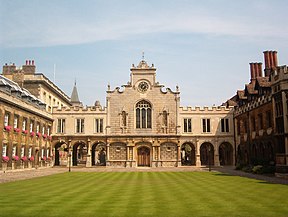Peterhouse College
| Peterhouse | |
|---|---|

Old Court facing the Chapel
|
|

Coat of Arms: four pales gules a border gules charged with golden crowns.
|
|
| University | Cambridge University |
| Location | Trumpington Street (map) |
| Founder | Hugo de Balsham, Bishop of Ely |
| Established | 1284 |
| Named for | Peter the Apostle |
| Previous names | The Scholars of the Bishop of Ely St Peter's College |
| Sister colleges |
Merton College, Oxford St Hilda's College, Oxford |
| Master | Bridget Kendall |
| Undergraduates | 260 |
| Postgraduates | 110 |
| Website | www |
| JCR | www |
| MCR | www |
| Boat club | www |
Peterhouse is a constituent college of the University of Cambridge, England. It is the oldest college of the university, having been founded in 1284 by Hugo de Balsham, Bishop of Ely, and granted its charter by King Edward I. Today, Peterhouse has 226 undergraduates, 86 full-time graduate students and 45 fellows. The modern name of Peterhouse does not include the word "college".
Peterhouse is one of the wealthiest colleges in Cambridge, with assets exceeding £250 million, including property in central London such as the Albany apartment complex in Piccadilly. Peterhouse is widely considered the most traditional of the Cambridge colleges. It is one of the few that still seeks to insist that its members attend communal dinners, known as "Hall". Hall takes place in two sittings, with the second known as "Formal Hall", which consists of a three-course candlelit meal and which must be attended wearing gowns. At Formal Hall, the students rise as the fellows proceed in, a gong is rung, and two Latin graces are read.
Academic performance tends to vary from year to year due to its very small student population; for example, Peterhouse came 25th in the Tompkins Table in 2007 but 7th in 2010, 12th in 2014 and 6th in 2015 (out of 29 colleges).
The college has five Nobel laureates associated with it, either as former students or fellows: Sir John Kendrew, Sir Aaron Klug, Archer Martin, Max Perutz, and Michael Levitt.
The foundation of Peterhouse dates to 1280, when letters patent from Edward I dated Burgh, Suffolk, 24 December 1280 allowed Hugo de Balsham to keep a number of scholars in the Hospital of St John, where they were to live according to the rules of the scholars of Merton. After disagreement between the scholars and the Brethren of the Hospital, both requested a separation. As a result, in 1284 Balsham transferred the scholars to the present site with the purchase of two houses just outside the then Trumpington Gate to accommodate a Master and fourteen "worthy but impoverished Fellows". The Church of St Peter without Trumpington Gate was to be used by the scholars. Bishop Hugo de Balsham died in 1286, bequeathing 300 marks that were used to buy further land to the south of St Peter's Church, on which the college's Hall was built.
...
Wikipedia
